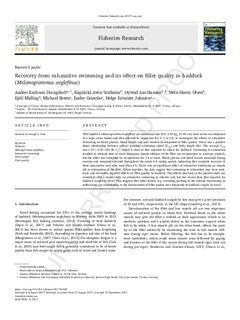| dc.contributor.author | Karlsson-Drangsholt, Anders | |
| dc.contributor.author | Svalheim, Ragnhild Aven | |
| dc.contributor.author | Aas-Hansen, Øyvind | |
| dc.contributor.author | Olsen, Stein Harris | |
| dc.contributor.author | Midling, Kjell Øivind | |
| dc.contributor.author | Breen, Michael | |
| dc.contributor.author | Grimsbø, Endre | |
| dc.contributor.author | Johnsen, Helge K. | |
| dc.date.accessioned | 2018-08-03T12:10:59Z | |
| dc.date.available | 2018-08-03T12:10:59Z | |
| dc.date.created | 2018-02-22T13:05:16Z | |
| dc.date.issued | 2018 | |
| dc.identifier.citation | Fisheries Research. 2018, 197 96-104. | nb_NO |
| dc.identifier.issn | 0165-7836 | |
| dc.identifier.uri | http://hdl.handle.net/11250/2507429 | |
| dc.description.abstract | Wild haddock (Melanogrammus aeglefinus) of commercial size (0.8–2.49 kg, 45–60 cm) were swum to exhaustion in a large swim tunnel and then allowed to recuperate for 0, 3 or 6 h, to investigate the effects of exhaustive swimming on blood glucose, blood lactate and post mortem development of fillet quality. There was a positive linear relationship between critical (aerobic) swimming speed (Ucrit) and body length (BL). The average Ucrit was 1.25 ± 0.29 (SD) BL s−1, which is close to that reported by others for haddock. Swimming to exhaustion resulted in reduced time to reach maximum muscle stiffness of the fillet (no recuperation vs unswum control), but the effect was remedied by recuperation for 3 h or more. Blood glucose and blood lactate increased during exercise and remained elevated throughout the entire 6-h resting period, indicating that complete recovery of these parameters may take more than 6 h. There was no significant effect of exhaustive swimming on muscle pH or colouration of the fillet. Taken together, the data suggest that swimming to exhaustion may have moderate and reversible negative effects on fillet quality in haddock. The effects observed in the present study are consistent with a recent study on exhaustive swimming in Atlantic cod, but less severe than that reported for haddock caught by trawl. This suggests that other factors (e.g. crowding/packing in the codend, barotrauma or suffocation) are contributing to the deterioration of fillet quality seen frequently in haddock caught by trawl. | |
| dc.language.iso | eng | nb_NO |
| dc.title | Recovery from exhaustive swimming and its effect on fillet quality in haddock (Melanogrammus aeglefinus) | nb_NO |
| dc.type | Journal article | nb_NO |
| dc.type | Peer reviewed | nb_NO |
| dc.description.version | acceptedVersion | |
| dc.source.pagenumber | 96-104 | nb_NO |
| dc.source.volume | 197 | nb_NO |
| dc.source.journal | Fisheries Research | nb_NO |
| dc.identifier.doi | 10.1016/j.fishres.2017.09.006 | |
| dc.identifier.cristin | 1567911 | |
| dc.relation.project | Norges forskningsråd: 203477 | nb_NO |
| dc.relation.project | Nofima AS: 21161 | nb_NO |
| dc.relation.project | Fiskeri- og havbruksnæringens forskningsfond: 900806 | nb_NO |
| cristin.unitcode | 7431,15,0,0 | |
| cristin.unitcode | 7431,0,0,0 | |
| cristin.unitname | Fangst | |
| cristin.unitname | Havforskningsinstituttet | |
| cristin.ispublished | true | |
| cristin.fulltext | postprint | |
| cristin.qualitycode | 1 | |
